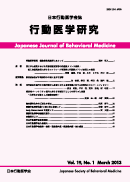All issues

Volume 13 (2007)
- Issue 1 Pages 1-
- Issue Supplement Page・・・
Volume 13, Issue 1
Displaying 1-3 of 3 articles from this issue
- |<
- <
- 1
- >
- >|
Review
-
Toyohiro HAMAGUCHI, Motoyori KANAZAWA, Shin FUKUDO2007Volume 13Issue 1 Pages 1-5
Published: 2007
Released on J-STAGE: July 03, 2014
JOURNAL FREE ACCESSVisceral pain sensitivity has been called a biological marker for irritable bowel syndrome (IBS). Recently developed symptom-based criteria provide the tools necessary to make a diagnosis and treatments. The precise underlying pathophysiology of IBS remains unknown. This article is a review of the psychological influences on visceral perception and hereditary determinant for background of IBS. Psychological factors influence pain thresholds in patients with IBS. Sensitization by repeated distention has been cited as evidence of a biological basis for hyperalgesia, and study of the brain imaging shows that different regions are activated by painful distention in patients with IBS. Variation of the gene promoter region is associated with sensitivity to stress and symptoms of IBS, this is consistent with psychological influences on perception. The brain-gut axis involving the central nervous system with genotype and psychological factors have emerged as an underlying concept for IBS.View full abstractDownload PDF (747K)
Original
-
Hirokazu ARAI, Toshihiko TSUTSUMI2007Volume 13Issue 1 Pages 6-13
Published: 2007
Released on J-STAGE: July 03, 2014
JOURNAL FREE ACCESSThe purpose of this study was to examine the influences of acute walking duration on the change of affects and to examine cognitive factor-determined affects with walking. The participants comprised 82 university freshmen. They were assigned either to the “15-min walking group” or to the “30-min walking group.” Two measures, namely, the Waseda Affect Scale of Exercise and Durable Activity (WASEDA) and the Feeling Scale (FS) are exercise-specific affect scales that consider affects with respect to walking bouts. Further, the cognitive factor-influenced affects with walking were considered. These comprised associative factors, namely, “paying attention to your body” and “your sweat” and dissociative factors, namely, “the person walking with you” and “the scenery along the road.” This study involved 2 groups that were twice subjected to between-groups and repeated-measures mixed designs. Participants were rated based on the WASEDA and FS before and after walking. Further, after walking, the participants were assessed for subjective exercise intensity (RPE scale) during walking and cognitive factor-determined affects with walking. We concluded that the change of affects and the evaluation of cognitive factor-determined affects did not differ with respect to walking durations (15 min or 30 min). In both groups, it was suggested that the dissociative factors, i.e., “the person walking with you” and “the scenery along the road” explained the affects after walking. Therefore, walking by using a strategy that focuses on dissociative factors (dissociative strategy) possibly influences the change of affects after walking in a more favorable manner than a strategy that focuses on associative factors (associative strategy) during walking.View full abstractDownload PDF (677K) -
Yuichiro ICHIKAWA, Keisuke SAITO, Asako YODA2007Volume 13Issue 1 Pages 14-22
Published: 2007
Released on J-STAGE: July 03, 2014
JOURNAL FREE ACCESSThe present study examined the effects of self-presentational efficacy as a situational determinant in social anxiety level on cardiovascular activity and psychological responses. Twenty undergraduate students asked to perform two public speaking tasks in front of two evaluators. Participants received a false feedback (high or low score) about their speaking abilities after they made a first speaking task. Blood pressure, interbeat interval, cardiac output, and total peripheral resistance were assessed during a rest and each condition. Participants' subjective affects were measured by means of AACL and PANAS. STAI-S was used to measure their state anxiety. Those psychological measures were obtained after a rest and between conditions. The results indicated that systolic, diastolic, and mean blood pressure in a low-score feedback group were increased during subsequent speaking task following the feedback more than a high-score feedback group. Cardiac output and negative affect responses were increased in a low-score feedback group more dominantly than a high-score feedback group. From these results, it is suggested that the declined self-presentational efficacy, which constitutes an important component of social anxiety would elevate cardiovascular activity.View full abstractDownload PDF (770K)
- |<
- <
- 1
- >
- >|